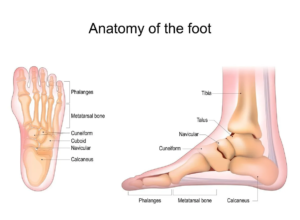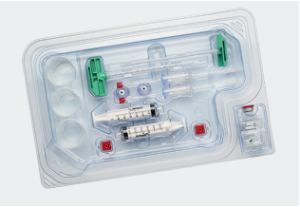Bone marrow aspirate concentrate (BMAC) is a biologic therapy for treating musculoskeletal injuries and
diseases. A healthcare provider extracts it from your bone marrow and injects it into your injured tissues
to help them repair and regenerate.
BMAC is a concentrated solution of cells and proteins extracted from bone marrow. It contains stem cells,
anti-inflammatory cytokines and growth factors — proteins that trigger cellular growth and repair.
Your bone marrow is the soft, spongy tissue at the center of your bones that produces your blood cells.
This process relies on stem cells and growth factors, making bone marrow an excellent source of them.
Healthcare providers harvest them in a procedure called bone marrow aspiration: They draw a sample of
the liquid part of your bone marrow through a hollow needle. The sample is called bone marrow aspirate.
Bone marrow aspirate concentrate (BMAC) is produced by processing and distilling this sample. The
concentrated form is about six times denser with cells and growth factors than the original aspirate.

Bone marrow aspirate concentrate (BMAC) is produced by processing and distilling this sample. The
concentrated form is about six times denser with cells and growth factors than the original aspirate.
Healthcare providers have been experimenting with using BMAC to help repair and regenerate damaged
tissues in your musculoskeletal system— tissues like muscles, bones, cartilage, tendons and ligaments.
If you’ve had a traumatic injury or have a degenerative tissue disease like osteoarthritis, BMAC can help
promote healing. It contains the raw cellular materials your body needs to regenerate these tissues.
A healthcare provider can treat your injured tissues with contents extracted from your own bone marrow.
After aspirating and concentrating the liquid, they can deliver it to the tissues that need it.
Surgery is one way of doing this. But a simpler way is to inject the liquid into the injured tissues through a
hollow needle. A BMAC injection is an outpatient procedure that you can get in your provider’s office.
BMAC contains concentrated doses of stem cells and growth factors, which stimulates tissue growth and
repair. Stem cells are cells in their raw form before they specialize to become different types of tissues.
Mesenchymal stem cells (MSCs) are the type of stem cells that replenish soft tissues, cartilage and bone.
They’re less abundant in bone marrow than other types, so a concentrated dose is more likely to help.
BMAC also promotes healing by reducing inflammation and scarring (fibrosis). Severe or long-lasting
inflammation can lead to scarring. While scarring is a type of healing, it’s not the same as regenerating.
Scar tissue is dense, fibrous tissue that may not have the same blood supply, flexibility or functionality as
the original tissue. But when tissues regenerate, they replace damaged cells with the same type of cell.
Healthcare providers have used BMAC injections to promote the healing of:
● Sports injuries, like bone fractures, tendonitis or partial tendon tears.
● Chronic and nonhealing wounds, like diabetes-related foot wounds.
● Musculoskeletal disorders, like degenerative arthritis and degenerative disk disease
● Dental bone grafts and implants during oral surgery

The BMAC procedure has three parts:
1. Bone marrow aspiration.
2. Bone marrow aspirate concentrating.
3. Bone marrow aspirate concentrate (BMAC) injection.
Bone marrow aspiration is the procedure where your healthcare provider will harvest your bone marrow
using a hollow needle. They’ll usually draw it from a large bone, like your pelvic bone or heel bone.
They’ll insert the needle through your heel bone. First, they’ll inject numbing medication. Once you’re
numb, they’ll attach a syringe to the needle and extract the bone marrow.
Different providers use different methods for processing and concentrating the aspirate. It takes about 30
minutes while you wait. When the BMAC is ready to use, your provider will collect it into a syringe.
The BMAC injection procedure is just like the extraction. Your provider will locate the injection site using
radiology imaging. They’ll numb the site first, and then inject the BMAC.
The whole procedure takes about two hours. After that, you can go home. If the injection site is sore,
apply ice and use over-the-counter (OTC) pain relievers as needed. Most people say this only lasts a few
days.
Bone marrow aspirate concentrate (BMAC) injections encourage tissue regeneration and healing from
musculoskeletal injuries and disorders. They aren’t a cure, but they can be a helpful complementary
therapy.
They can:
● Reduce symptoms like inflammation, pain and stiffness.
● Kick-start healing of nonhealing or chronic wounds.
● Help you recover faster from injuries.
● Potentially enhance your response to reconstructive surgery or grafting.
There’s little risk of complications from BMAC injections. The most common side effect is temporary pain
and swelling, lasting a few days. Other possible negative outcomes include:
● A temporary inflammatory reaction, like a fever or rash
● Excessive bleeding or infection at the injection site.
● Injury to nearby blood vessels or nerves.
● No improvement from the treatment.
BMAC injections have shown encouraging results in treating all kinds of musculoskeletal conditions. But
they’re still a new treatment, and there’s not enough evidence yet to say they’ll work for everyone.
Different factors may affect how well BMAC works for you, including the condition you’re treating, how
advanced it is and your overall health. Your provider can tell you more about what you can expect.
Additional Common Questions
What’s the difference between BMAC therapy vs. PRP therapy?
BMAC and PRP (platelet-rich-plasma) are both examples of newer biologic therapies for musculoskeletal
conditions. Biologics are therapeutics derived from organic life — in this case, from your own body.
While BMAC comes from your bone marrow, platelet-rich plasma is a blood product drawn from a
vein.Processing concentrates the platelets in the blood sample — the clotting factors that help seal
wounds.
Like BMAC, PRP contains growth factors and anti-inflammatory agents that can help encourage tissue
healing and reduce discomfort. But PRP doesn’t contain live mesenchymal stem cells like BMAC does. Both have shown benefits for treating musculoskeletal conditions, but BMAC offers greater potential for
tissue regeneration because of the stem cells it contains. Some providers suggest using both together.
Bone marrow aspirate concentrate (BMAC) is still a new and experimental therapy. Healthcare providers
are still discovering its full potential for treating musculoskeletal conditions and how best to apply it.
But for those who live with chronic wounds or degenerative joint diseases that haven’t responded to other
treatments, potential means a lot. Injections are a simple way to see what BMAC could do for you.
Dr. Neha Pathak brings extensive experience to her role as a podiatrist at Pathak Podiatry.
Managed & Designed by – Alltic Healthcare